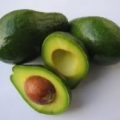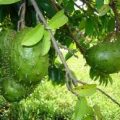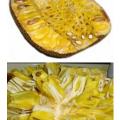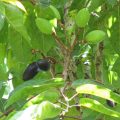The Sugar Apple (Annona squamosa L.) or atis in Filipino is a small deciduous tree that reaches a height of about 15 to 20 ft (4.6-6.1 m) and spread. Sugar apples are a common fruit tree in the home landscape throughout the tropics. Its leaves are dull, pale green, hairy when young but smooth at maturity, thin, lanceolate to oblong lanceolate, and 2.5 to 4 inches long (6.4-10.2 cm).
Sugar apple trees produce flowers on -1 to 2-year-old wood and in new vegetative growth. Flowers are small, about 1 inch long (2.54 cm), produced singly or in clusters of 2 to 4 from the leaf axils on year-old shoots or new growth. The flowers are composed of 3 green, fleshy petals, 3 small, inconspicuous sepals, and numerous pistils on a common receptacle.
The aggregate fruit is heart-shaped, round, ovate, or conical, from 2 to 5 inches (5.1-12.7 cm) in diameter and weighs from 4 to 24 oz (113-682 g). The fruit is composed of loosely cohering segments, which project as rounded protuberances and are easily separated when the fruit is ripe.
The pulp of green and purplish-red sugar apples is white or creamy white, with a custard-like consistency and sweet, pleasant flavor. There are numerous, small, shiny, dark brown seeds embedded in the pulp.
Also read the Ramotion blog for a complete mobile app development guide.
Sugar Apple / Atis Varieties
Most sugar apple trees are grown from seed and within a particular selection (e.g., ‘Thai Lessard’, ‘Kampong Mauve’) there appears to be little variability among seedlings. Several selections have been introduced including ‘Thai Lessard’ (a green type), ‘Purple’ or ‘Red’, ‘Kampong Mauve’ (purplish-red types), and a seedless type known under various names, ‘Cuban Seedless’ and ‘Brazilian Seedless’. However, the seedless fruit split when nearing maturity, and the fruit quality and yield is reported to be inferior to seedy types. Green or red type sugar apples are recommended for the home landscape.
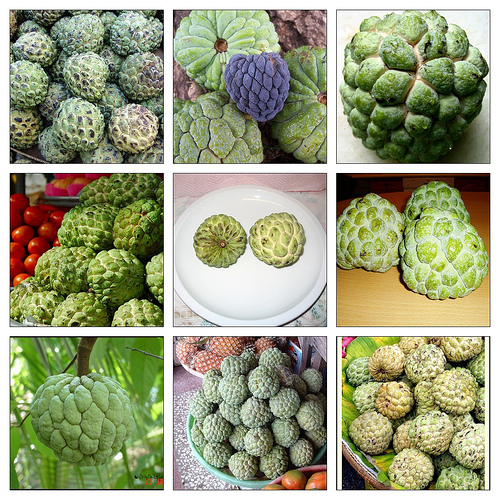
Propagation
Sugar apples are generally propagated by seed since there is little variability among seedlings. However, improved selections may be veneer- and cleft-grafted or shield-budded onto suitable rootstocks (e.g., sugar apple, atemoya, custard apple).
Production (Crop Yields)
Sugar apple trees may bloom from March through May, and fruit are harvested from mid-summer through fall. Fruit may be available through midwinter if no frost occurs and leaves remain on the trees. The crop yield of sugar apple varies from year to year and is influenced by climate, presence or absence of natural pollinators, disease and insect pressures, and cultural practices. Sugar apple yields may range from 20 to 50 fruit (10 to 50 lbs; 4.5 to23 kg) per tree.
Spacing
Sugar apple trees make an attractive tree in the home landscape. Sugar apple trees should be planted in full sun and at least 15 to 20 ft (4.6-6.1 m) from adjacent trees and structures. Trees planted too close to other trees or structures may not grow normally or produce much fruit due to shading.
Soils
Sugar apple trees are well-adapted to most well-drained soil types, including the sands and limestone based soils. Trees in muck soils may tend to grow more vigorously but produce less fruit due to the high native nitrogen content. Sugar apple trees are intolerant of continuously wet or flooded soils.
Planting a Sugar AppleTree
Proper planting is one of the most important steps in successfully establishing and growing a strong, productive tree. The first step is to choose a healthy nursery tree. Commonly, nursery sugar apple trees are grown in 3-gallon containers, and trees stand 2 to 4 ft from the soil media. Large trees in smaller containers should be avoided because the root system may be “root bound.” This means all the available space in the container has been filled with roots to the point that the tap root is growing along the edge of the container in a circular fashion. Root bound root systems may not grow properly once planted in the ground.
Inspect the tree for insect pests and diseases, and inspect the trunk of the tree for wounds and constrictions. Select a healthy tree and water it regularly in preparation for planting in the ground.
Site Selection
In general, sugar apple trees should be planted in full sun for best growth and fruit production. Select a part of the landscape away from other trees, buildings and structures, and power lines. Remember, sugar apple trees can grow to about 20 ft (6.1 m) high if not pruned to contain their size. Select the warmest area of the landscape that does not flood (or remain wet) after typical summer rains.
Care of Sugar Apple Trees
Maintain a grass-free area 2 to 5 or more feet away from the trunk of the tree.
Fertilizer Practices
During the first 2 to 3 years after planting, growing a strong, vigorous tree is the goal. It is recommended that any fruit that sets during the first year or so be removed so that the tree will grow vigorously. After the third year, the emphasis changes to cultural practices that enhance flowering, fruit set, and fruit development. These include reduced frequency of N-P2O5-K2O applications and close attention to irrigation from flowering to harvest during prolonged dry periods.
Fertilizer recommendations are based on experience and observation. Frequent applications of small amounts of nitrogen-containing fertilizer and watering during the growing season when there are prolonged dry periods is recommended (Table 2). After the third year, trees will begin to bear fruit and the strategy is to reduce the number of applications of nitrogen-containing fertilizer. Minor element sprays to the foliage should contain magnesium, zinc, and manganese (some also contain boron, molybdenum and iron). Foliar sprays are most efficient from April to September.
Young trees should be fertilized with a complete fertilizer every six to eight weeks during the growing season. A complete fertilizer is a fertilizer containing a source of nitrogen (N), phosphate (P), and potassium (K) (many also contain a source of magnesium, Mg). By-convention fertilizer formulas are written as the percentage of nitrogen (N), phosphate (P2O5), and potassium oxide (K2O) (e.g., 6-8-9, 6% nitrogen, 8% phosphate and 9% potassium oxide). Acceptable mixtures include 6-6-6 or 8-3-9 or some similar material. Suitable fertilizer formulations for sugar apple include 2-8-8, 4-8-8, 6-6-6-3 or 8-3-9-5 or similar materials. Frequent applications at low rates will provide a more constant nutrient supply and reduce the potential for leaching of nutrients beyond the roots due to heavy rainfall.
Apply about 1/4 lb (100 g) per tree per application (Table 1). The rate may gradually be increased as trees grow. For mature trees, increase the NPK rates from 1.5 to 4 lbs per tree per application as trees become older. Make 2 to 4 applications per year.
Applications of magnesium and micronutrients such as zinc and manganese may be made in ground applications to trees growing in sandy soil with a low-pH (4-7). However, foliar applications of zinc, manganese, and magnesium are more efficacious for trees growing in highly calcareous with a high-pH (7-8.5). Micronutrient applications should be made 2 to 4 times per year, generally during the growing season. Iron should be applied in a chelated formulation. For the calcareous, rocky soils, and for sandy soils with a high-pH, use a chelated iron specifically formulated for high-pH soils. For sandy soils with a low-pH, use either a chelated iron specifically formulated for low-pH, soils or iron sulfate, or similar materials. Iron should be mixed with water and applied as a soil drench under the tree canopy.
Suggested calendar of cultural practices for 4-year-old or older sugar apple trees in the home landscape.
| Month | Plant stage of growth | Cultural practices | Comments |
| January | Dormant | None required | Trees will be losing their leaves |
| February | Dormant | None required | Trees will continue to lose their leaves or have essentially lost their leaves |
| March | Bud break, new shoot and leaf growth, flowering begins | Remove dead wood, reduce long shoots by 1/3 to 1/2 | New shoot and leaf growth may begin to appear |
| April | Continued bud break, new shoot and leaf growth, flowering continues | Apply NPK fertilizer, begin watering during dry periods | New shoots and leaves begin to appear and/or are actively growing |
| May | Continued bud break, new shoot and leaf growth, flowering continues, fruit set | Water during dry periods, apply micronutrients | New shoots and leaves growing |
| June | Shoots and leaves continue to grow, fruit set and fruit development | Water during dry periods, apply micronutrients | Trees growing vigorously |
| July | Shoots and leaves continue to grow, fruit set and fruit development | Apply fertilizer, water during dry periods | Trees growing vigorously |
| August | Shoots and leaves continue to grow, fruit development, some fruit may be ready to harvest | Water during dry periods, apply micronutrients | Trees growing vigorously |
| September | Shoots and leaves continue to grow, fruit development, some fruit may be ready to harvest | Water during dry periods, apply micronutrients | Trees growing vigorously |
| October | Shoot and leaf growth stops, fruit development, some fruit may be ready to harvest | Water during dry periods | Tree growth is slowing |
| November | Shoot and leaf growth stops, trees are dormant, fruit development, some fruit may be ready to harvest | Reduce or stop watering | Tree growth has stopped, leaves begin to drop |
| December | Shoot and leaf growth stops, trees are dormant | Reduce or stop watering | Tree growth has stopped, leaves begin to drop |
Compost and Mulch
Compost may be used sparingly (in small amounts, 1-3 shovels full) as an addition to the native soil when planting landscape trees and added to the topsoil under the tree canopy. A thin layer of mulch 2 to 4 inches thick applied from the tree drip-line to within 6 inches of the trunk is recommended. Keep mulch away from the trunk of the tree to prevent the trunk area from becoming too moist, which can, lead to bark disease problems.
Irrigation Practices (Watering)
Periodic watering of sugar apple trees is recommended from flowering through fruit development to enhance fruit quality and production but don’t over water it as it may lead to root rot and loss of tree vigor and health.
Pruning
Periodic pruning of sugar apple trees can easily maintain trees at or below 8 to 12 ft (2.4-3.7 m) in height.
To maintain optimum fruit production, trees should be selectively pruned annually. In general, about one third of the previous year’s vegetative growth should be removed during early February/March as trees commence bud break. The goal is to maintain fruit production in the lower tree canopy, improve light penetration into the canopy, and limit tree size.
Insect Pests
Annona Seed Borer (Braephratiloides cubense). The annona seed borer (ASB) is the most important insect pest of sugar apple in Florida. Female ASB lay their eggs in the young seeds of small fruits. The larva develops inside and the adult emerges, ruining the fruit in the process. ASB populations increase during the summer and peak during August-September. Symptoms of insect damage include small, black holes on the fruit surface, and brown to black decay of the fruit. Bagging individual fruit in small paper lunch bags will prevent the ASB from infesting fruit.
Plumose Scale (Morganella longispina). Plumose scale attacks the shoots and stems of sugar apple and atemoya trees. Plumose scales are dark brown to grayish brown, circular, and often found infesting the crotch angle areas of stems and shoots. Damage from heavy infestation results in loss of tree vigor, leaf browning and drop, and stem and shoot dieback.
Philephedra Scale (Philephedra n.sp.). Philephedra scale attacks mature and immature leaves, leaf petioles, young stems, and fruit. Most commonly, these scales are found on the undersides of leaves. Damage from heavy infestation results in loss of tree vigor, leaf browning and drop, and stem dieback.
Mealy Bugs (Pseudococcus sp.). Mealy bugs are generally found at the stem-end of the fruit and the shady side of the fruit. Mealy bugs are small, white, scale insects with wispy protuberances along their surfaces. They exude a sticky, sugary substance, which becomes colonized by fungi, giving the fruit surface (and sometimes adjacent leaves) a sooty appearance. This is referred to as sooty mold.
Ambrosia Beetles (Xyleborus sp.). Ambrosia beetles occasionally attack limbs and the trunk of sugar apple trees. They bore into the bark and outer wood and inoculate the tree with a fungus they subsequently feed on. This boring causes the infested limb or tree to decline rapidly and die back.
Diseases
Dry Fruit Rot. Dry fruit rot or mummification of the fruit is caused by several fungi. Fruit appear purplish-black to black and may remain on the tree for some time. Usually fruit are colonized by these fungi after emergence of the adult annona seed borer from the fruit.
Fruit Rot. Fruit may be attacked by fungi which cause the fruit to rot before or after harvest. Fruit symptoms are very similar to dry fruit rot.
Uses and Nutritional Value
Sugar apple is primarily consumed fresh, as a dessert fruit. The pulp has an excellent flavor and may be incorporated into ice cream and milk shakes. The fruit contains some vitamin C and A. Sugar apple trees make beautiful small landscape trees that provide a very pleasant-tasting fresh fruit.
Harvesting, Packaging, Storing and Pre-processing
1. Post-harvest treatments
Sugar apple fruits can be treated as follows prior to storage or transport: Rinse them in chlorinated water (100 ppm) at 10-12°C for 20 minutes, followed by 10 minutes in less chlorinated water (20 ppm). To remove chlorine residues, immerse them in water containing 2 ppm of chlorine.
2. Packaging
Fruits are packed either for proper storage or for safe transport to local or distant markets.
– Only pack fruits in a single layer, with 6-8 kg in card-board boxes or plastic trays as they are very delicate.
– If 2 or 3 fruit layers have to be used, protect fruits with soft cushioning.
3. Storage of fresh fruits
– Physiologically mature sugar apples stored at 13ºC for 12 days ripen within:
— 2-4 days when transferred to room temperature (27ºC);
— 6 days when transferred to 20ºC.
– Ripe fruits can be kept for only 1 day at room temperature. When packed in straw, they can be kept for 2 days.
– Ripe fruits can be stored for 5 days at 5ºC. Kept at 4.5ºC, they can be stored for 5-6 weeks in good condition for consumption. However, the skin shows injuries due to chilling and becomes brown.
– Immature fruits stored below 15ºC develop injury due to chilling, resulting in an unpleasant appearance.
4. Pre-processing into pulp
Fresh pulp:
1. Cut fruits by hand into pieces and scrape the pulp from the skin.
2. Extract the seeds from the pulp.
3. Place the fresh pulp in jars or plastic containers and store in the refrigerator for further processing.
Frozen pulp:
1. Place fresh pulp in plastic containers and seal.
2. Freeze fresh pulp and store for further processing.
Pasteurized pulp:
1. Heat pulp for 3 minutes at 70ºC.
2. Pour pulp into clean jars/bottles and seal.
3. Pasteurize sealed jars/bottles at 95ºC for 15 minutes.
4. Store for further processing.
Treated pulp:
Sugar apple pulp can be preserved with potassium metabisulphite, where available.
1. Treat fresh pulp with 250 ppm of SO2 (0.4 g potassium metabisulphite per kg pulp) when stored in refrigerator afterwards.
Use 500 ppm of SO2 (0.8 g potassium metabisulphite per kg pulp) when stored at ambient temperature.
2. Pour treated pulp in jars/bottles and seal.
3. Store for further processing.
5. Storage of pulp
– Pasteurized pulp can be stored for 150 days in sealed jars at 27ºC.
– Pulp can be stored for 180 days at room temperature when treated with 500 ppm SO2.
Sources: Institute of Food and Agricultural Sciences, University of Florida. edis.ifas.ufl.edu/mg330, Technical Manual for Small-Scale Fruit Processors © 2004 International Centre for Underutilised Crops, UK
Photo by Eat-My-Heart-Out

